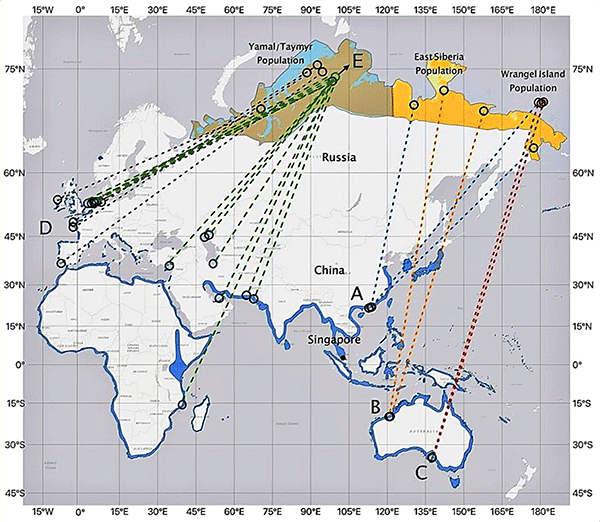Mystery Migration: Grey Plover’s Arctic Journey Challenges Assumptions
Satellite tracking reveals an unexpected route from Southeast Asia to Siberia.
A groundbreaking study has reshaped our understanding of the migratory patterns of the Grey Plover (Pluvialis squatarola), a shorebird that winters in Southeast Asia. Researchers using satellite transmitters have tracked an individual bird from Singapore to its breeding grounds in north-central Siberia, revealing a migration route that challenges long-held assumptions about population delineations.
A Journey Full of Surprises
Traditionally, it was believed that Grey Plovers wintering in Southeast Asia belonged to a population that breeds in East Siberia or Alaska. However, the study, published in Ecology and Evolution, provides the first evidence that at least some of these birds may actually belong to the Yamal/Taymyr population, which was previously thought to migrate only via the East Atlantic Flyway to winter in Western Europe.
The tracked Grey Plover took an astonishingly long journey, covering over 8,600 km during its northward migration and 12,100 km on the return trip. The bird made strategic stopovers in China’s Yellow Sea region and inland wetlands before reaching its breeding site east of the Taymyr Peninsula.
Unexpected Detours and Climate Clues
One of the most surprising aspects of the journey was the bird’s post-breeding migration. Instead of heading directly south, it first moved westward to northwestern Taymyr, stopping twice for extended periods. This deviation defied the prevailing winds and may indicate an effort to replenish fat reserves before embarking on the long southward journey or possibly to explore new potential breeding sites.
The researchers suggest that these movements might be linked to climate-driven habitat changes. “With rising temperatures affecting Arctic tundra ecosystems, birds may be adjusting their migration routes to track shifting food resources or investigate alternative nesting grounds,” explains lead author David Li.

Why Avoid the Himalayas?
Another unexpected finding was the bird’s return migration route. Instead of flying south over the towering Himalayan mountains—an arduous route taken by some other shorebirds—it veered eastward from China’s Xinjiang region toward the coast before heading south. This detour, adding roughly 2,000 km to its journey, likely allowed the bird to take advantage of favorable wind conditions, reducing the energetic cost of migration.
Implications for Conservation
The discovery underscores the need for better protection of critical stopover sites along the East Asian–Australasian Flyway. The wetlands of the Yellow Sea, which provide vital refuelling stops for many migratory shorebirds, are under threat from habitat loss and development. If these areas continue to decline, birds like the Grey Plover could face even greater challenges in completing their long-distance migrations.
Additionally, the study raises new questions about population connectivity. If Grey Plovers wintering in Southeast Asia originate from multiple breeding populations, conservation strategies may need to be revised to account for these previously unrecognized links.
A Call for More Research
While this single tracked bird offers invaluable insights, researchers stress the need for further studies to determine whether other Grey Plovers in the region follow similar migration patterns. More satellite tracking and genetic analyses will help clarify the full extent of these surprising Arctic-Southeast Asia connections.
For now, the Grey Plover’s journey serves as a reminder that nature’s patterns are often more complex than we assume—and that even the most well-traveled routes may still hold surprises.
28 Feb 2025
Read the full paper here.
Share this story








